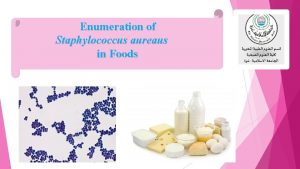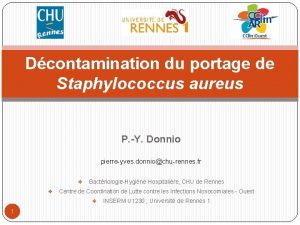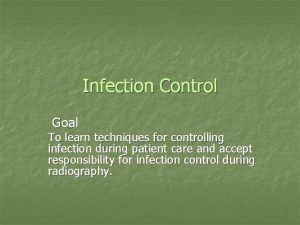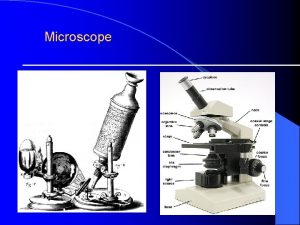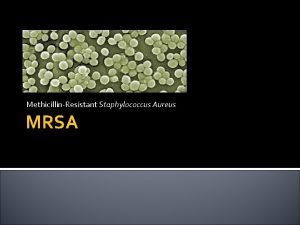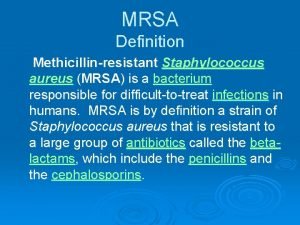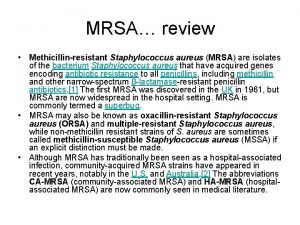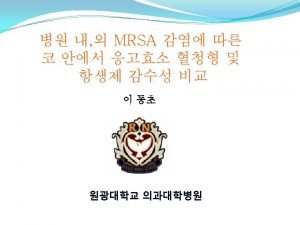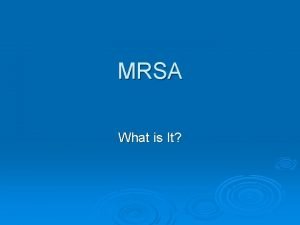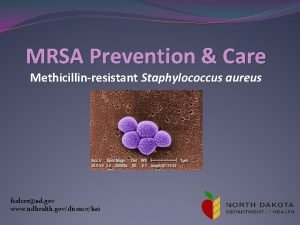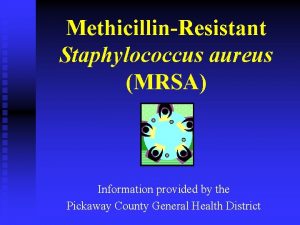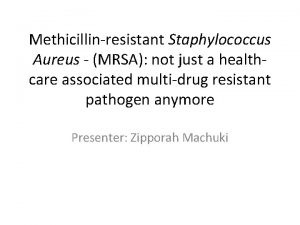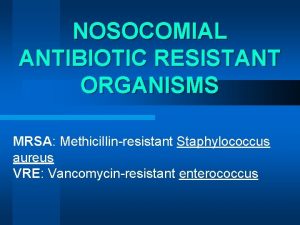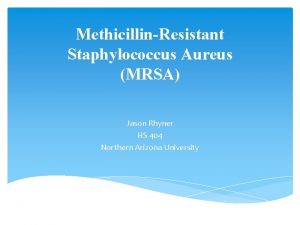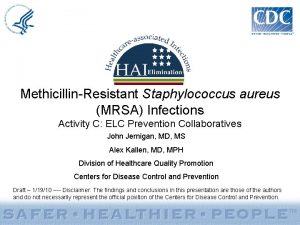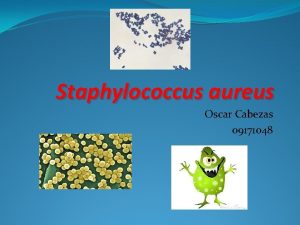MethicillinResistant Staphylococcus aureus MRSA in the School Setting



















- Slides: 19

Methicillin-Resistant Staphylococcus aureus {MRSA} in the School Setting Presented by: T. Williams University of Central Florida

• I have bugs… • You have bugs… • Community has bugs… & • Schools have bugs… • Bugs, Bugs & Bugs!!!!

Objectives • After this learning experience, participants will be able to: – – – Define MRSA. Explain importance of covering wound in school setting. Demonstrate applying dressing during skills check-off. Describe three ways to prevent the spread of MRSA at school. Select any portion of learning experience and provide comments regarding that particular portion on the blog. – Demonstrate appropriate hand washing technique.

What is MRSA? • Methicillin-resistant Staphylococcus aureus or MRSA – Staph infection – Resistant to certain antibiotics – Can cause skin or other types of infections (CDC, 2007). • MRSA – Hospitals for some time – Recently emerged in community settings

MRSA Podcast • This is a podcast on MRSA that was done by the Centers for Disease Control (CDC).

Signs and Symptoms • Most MRSA in the community appear as a skin infection in the form of pustules or boils (CDC, 2007). • May be bump or area that may be: • • • Red Swollen Painful Warm to touch Pus or drainage Accompanied by fever


Spread of MRSA • MRSA is spread: – Direct contact with a person who is infected – Contact with personal items that have been on or touched infected skin • The CDC identifies 5 factors (5 C’s) that make the spread of MRSA easier: • • • Crowding Contact (frequent skin-to-skin) Compromised (Skin) Contaminated (items and surfaces) Cleanliness (lack of)

Spread in School • Most children spend about 7 hours in a school 5 days per week • Increased crowding and contact which places them at risk for MRSA infection • Sports – Basketball, football, wrestling, etc. ----contact – “Sports habits” (i. e. sharing towels, razors, etc. ) • Student not to participate if open, oozing wound present

MRSA in school • Not student or parent diagnosed – Diagnosis made by physician • Once confirmed verify if any special orders for care at school – Goal keep wound/infected area clean and dry – Avoid anyone else having contact with infected area – Area should be covered while at school – No need for student to be excluded

Applying Dressing • See website below for detailed description of application of dry dressing… – http: //www. ohiohealth. com/documents/orthope dics/L 11_dry_dressing_change. pdf

How to Prevent MRSA spread • Keep wound covered while in school. • Avoid close contact with wound or area around wound. • Don’t share personal items. • After contact with wound, bandages, or area around wound • Wash hands!

Communication • Key! • Open communication – Parents and students – School – Nurse and nursing supervisor – Epidemiology (if necessary)

Hand washing • Use soap and warm water • Wash vigorously for at least 20 seconds • Wash all surfaces and nails • Rinse • Dry with clean paper towel • Use paper towel to turn off faucet (Clean hands, CDC, 2008)

Confidentiality • Students’ information is confidential • Not necessary to make announcement to entire school • Teachers, faculty, administration notified on need-to-know basis

Education… • Educate Students, parents, staff, faculty and administration on MRSA, spread, and prevention • Use websites as resource for materials (get “ok” from supervisor before distribution) • Encourage hand washing, good personal hygiene practices, not sharing personal items • Encourage student to take full course of antibiotic

MRSA in schools • • Please visit website More information on MRSA Copy of this presentation on website Blog also on website – Recommended use --sharing of resources, helpful tips, etc. – Comments on presentation – CONFIDENTIALITY- BEWARE!

MRSA… • Questions and Answers… • Open discussion…

References • Clean hands save lives. (2008) Retrieved March 18, 2009 from http: //www. cdc. gov/cleanhands/ • Questions and Answers about Methicillin-Resistant Stpahylococcus aureus (MRSA) in Schools. (2007). Retrieved March 16, 2009, from www. . cdc. gov/Features/MRSAin. Schools/ • About MRSA. (2008). Retrieved March 16, 2009, from www. cdc. gov/mrsa/
 Confirmatory test for staphylococcus aureus
Confirmatory test for staphylococcus aureus Staphylococcus
Staphylococcus Staphylocoque mrs1
Staphylocoque mrs1 Fastidious organisms
Fastidious organisms Staphylococcus aureus vs streptococcus pyogenes
Staphylococcus aureus vs streptococcus pyogenes Etiolgia
Etiolgia Staphylococcus saprophyticus hemolysis on blood agar
Staphylococcus saprophyticus hemolysis on blood agar Nitrate reduction test staphylococcus aureus
Nitrate reduction test staphylococcus aureus Staphylococcus aureus?
Staphylococcus aureus? Staphylococcus aureus kingdom
Staphylococcus aureus kingdom Enzymes of staphylococcus aureus
Enzymes of staphylococcus aureus Nummular eczema
Nummular eczema Staphylococcus aureus
Staphylococcus aureus Staphylococcus aureus bacteria structure
Staphylococcus aureus bacteria structure Staphylococcus aureus cocci or bacilli
Staphylococcus aureus cocci or bacilli Enzymes of staphylococcus aureus
Enzymes of staphylococcus aureus Which compares prokaryotes and eukaryotes
Which compares prokaryotes and eukaryotes S. epidermis
S. epidermis White
White Mac plate results
Mac plate results
